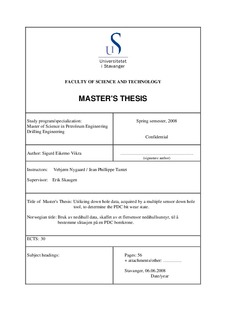Utilizing down hole data, acquired by a multiple sensor down hole tool, to determine the PDC bit wear state.
Master thesis

Åpne
Permanent lenke
http://hdl.handle.net/11250/183561Utgivelsesdato
2008Metadata
Vis full innførselSamlinger
Sammendrag
By using real-time data from INTEQ`s CoPilot Real-Time Drilling Optimalization a search for dependable indications of the degree of the bit wear was done. This would improve decision making procedures for when to pull the bit when experiencing a poor penetrationrate in soft formations or problems getting through harder formations.
Using several recorded runs, factors that might be good indicators of the drill bit state of wear was investigated by comparing several bit runs that were using a PDC bit with an Auto Trak X-Treme motor and a CoPilot sub assembly. Some of the possible suggestions did not seem viable to determine the wear of the bit. Some looked viable in some cases, but then again had exceptions in other runs under other conditions. At the end only two of the indications seemed usable to determine the wear of the bit. ROP compared to WOB was in almost every run a good indicator. But the most reliable indicator of bit wear in the runs investigated, was the degree of reduction of torque relative to the applied WOB. When recording these parameters with a new bit in early sections, using this as a basis for comparison with later measurements, it was possible to see if the torque generated had declined once a similar formation appeared again.
A third possibility that was not fully investigated was recording increase in mud pressure due to blocked nozzles. This theory was not easy to investigate since there were no available raw data, and the resolution in graphs was too low for the accuracy required.
Beskrivelse
Master's thesis in Petroleum engineering